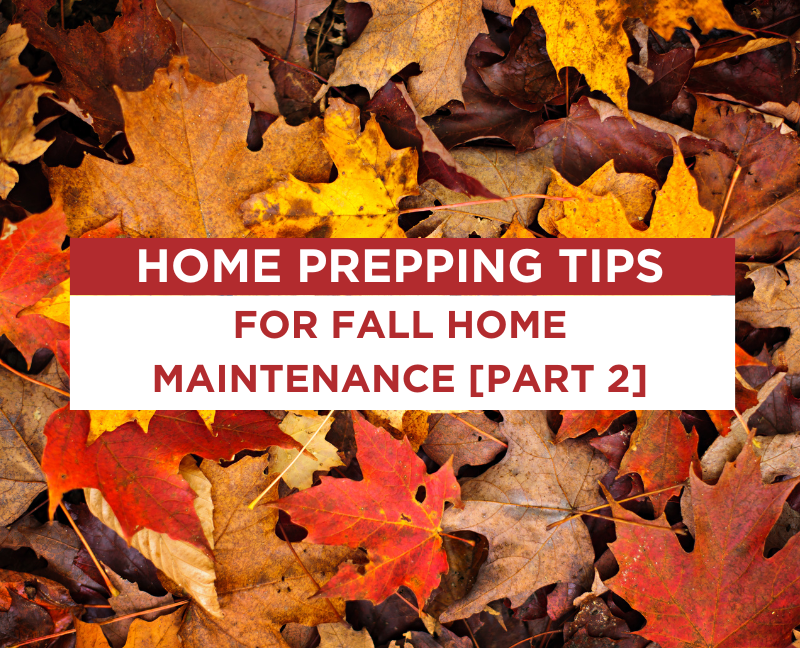In the first part, we've listed 7 home prepping activities you can do this fall. This includes cleaning your gutters, repairing air leaks, checking your roof for potential issues, and preventing freezing temperatures from damaging faucets.
We also talked about the proper cleaning of the furnace filters, getting the furnace checked by a professional, and examining the fireplace for damages. Now, we've added more home-prepping repairs and maintenance that are doable by the typical homeowner prep.
However, keep in mind that hiring a professional may be worth it, especially when the homeowner issues are severe. At the end of the day, preventing home damages does not only save time but also money in the long run.
Homeowner Prep Tips For Fall
Home Prepping #8: Maintain The Humidifier Working
Dry winter air can be hard on your skin and airways and may also break your beautiful wood. Maintaining your central humidifier will make your home more comfortable. Check the plates or pads and clean them with a strong washing detergent to start. Meanwhile, you can remove mineral deposits using a wire brush or steel wool.
Home Prepping #9: Prevent Gas Issues
Keep a gas heater maintained in good condition for safety and cost. An unmaintained heater can release harmful gasses into your home or cost extra. Have a pro inspect these devices annually. Also, perform some maintenance. First, turn off the heater. Check the air shutter and exhaust vents for dust. If they're unclean, vacuum the burner's air tubes and clean the burner. Follow manufacturer instructions for other maintenance.

Home Prepping #10: Keep The Fires In The Wood Blazing Brightly
Your home will feel cozier and warmer with a wood-burning stove, but regular maintenance is required to prevent safety hazards.
When checking the wood-burning stove, follow these steps:
- Check The Stovepipes: Stovepipes connected to wood-burning stoves might develop cracks that allow poisonous fumes to enter your house. You should watch for corrosion, holes, and loose joints throughout the heating season. After cleaning the stovepipe, search for degradation or looseness. On the other hand, if the problem is severe or cannot be fixed, you might need to replace your stovepipe instead.
- Examine For Corrosion And Cracks: Look at the stove's body and legs for any indications of corrosion or cracking.
- Inspect Safety Features: Check that the device is on an authorized floor and that anything that requires wall protection is set up per the manufacturer's instructions. To protect young children, fence off the stove once it's on.
Home Prepping #11: Fix The Walkways
Improper walkways, roads, and steps are dangerous year-round, but cold weather worsens them. Fall repairs are also essential to avoid costly cracks. Look for uneven parts, loose step rails, and over 1/8-inch broad cracks. Check loose-fill routes for asphalt disintegration or washouts. A DIYer can do most of the little work, but major repairs require expertise.
Home Prepping #12: Check Safety Features
Check your home's safety features from top to bottom at least once yearly. This would also be an excellent opportunity to review your family's fire evacuation plan.
To perform a safety check on your house, follow these steps:
- Fire Extinguishers: One all-fire extinguisher should be in every home. A minimum of one near the kitchen and one on each floor is fine. To ensure the extinguisher is charged, check the pressure gauge indication annually. The discharge nozzle should be unclogged, and the lock pin should be secure.
- General Clean-Up: Remove newspapers and harmful household chemicals from your home. Keep flammables and poisons in authorized, labeled containers—clear space between heaters, furnaces, and other heat sources.
- The Smoke And Carbon Monoxide Detectors: Replace smoke and CO detector batteries and vacuum with a soft brush. Push the test button or hold a smoke source nearby to test the detectors. Install smoke detectors on all floors, including the basement.
- Fire Escape Plans: Every bedroom, including basements, needs two exits. Make sure to keep windows clear of furniture and other items. Emergency evacuation rope ladders should be near windows in upper-floor bedrooms. Review fire safety and find a safe gathering spot away from home.
Home Prepping #13: Get Your Lawn Ready For Winter
Many fall lawn care tasks are necessary to maintain your lawn's condition and attractiveness in spring. Rake leaves and aerate to avoid choking your lawn and flower beds. They'll sleep well if you fertilize and winterize your grass, trees, and shrubs. Professional lawn care services can complete these tasks quickly, allowing up time for family, friends, and others.
Home Prepping #14: Exterior Touch-Ups
Fall is an excellent time to touch up exterior paint and prolong siding and trim life. Porch stairs and wood floors should also be painted or sealed before snowfall. Since many paint jobs aren't recommended on days below 45° to 50°F, finding a local painter or doing the process yourself sooner is best.
Home Prepping #15: Do Some Carpet Cleaning
Fall in Indiana is a good carpet cleaning season. Winter is yet to arrive, but summer is over. Window ventilation is best at this time to hasten drying. Let a pro handle a carpet cleaner if you're uncomfortable using it. A home full of damp carpet will make you want to enjoy the warm days outside.
We hope that these tips can help you prepare for this wonderful season. For more home maintenance tips, you may visit our website today!

